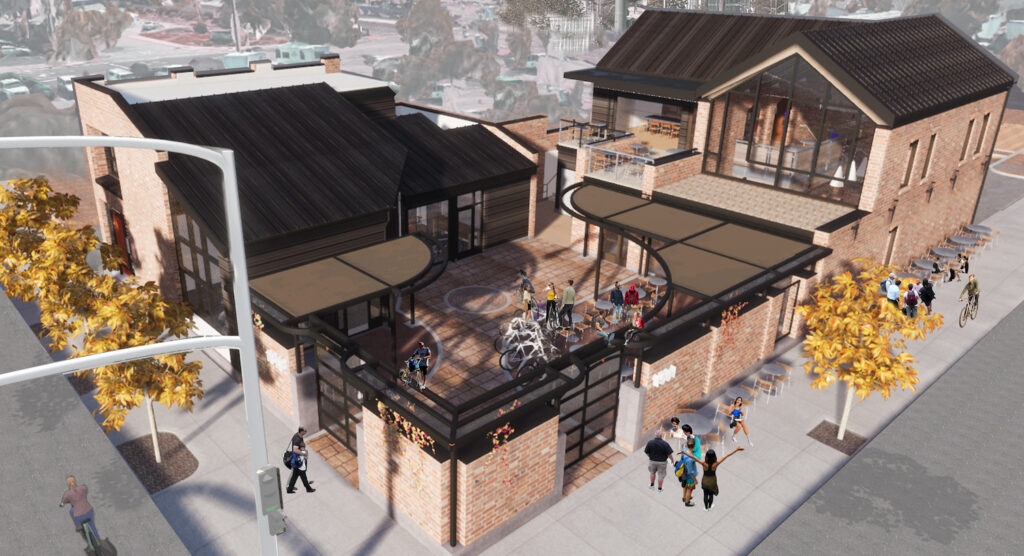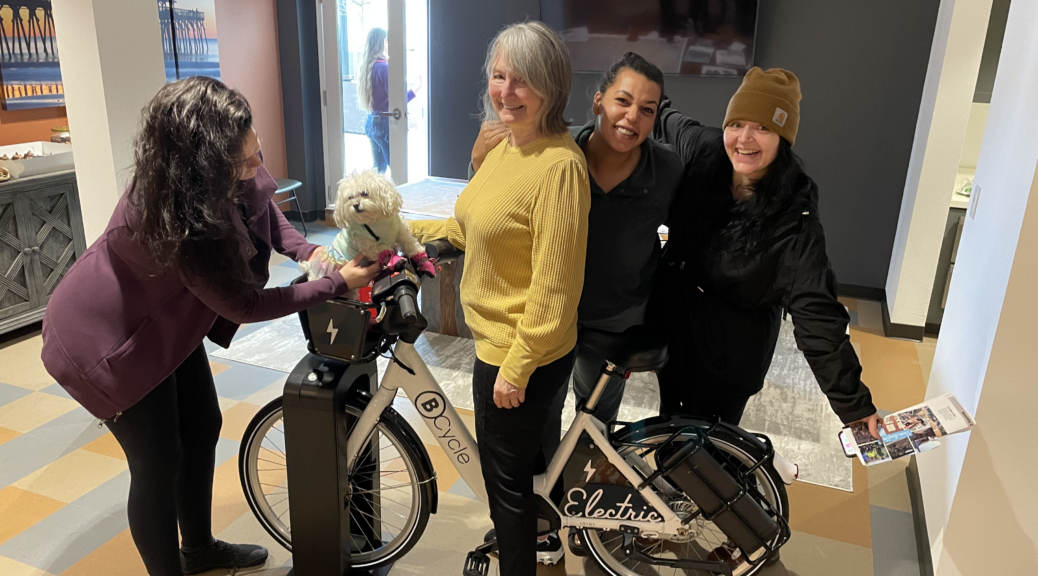BY KIRAN HERBERT, COMMUNICATIONS MANAGER
The Northern California town’s new bike share system is first and foremost geared towards low-income residents living downtown.
“Some people just tag things on at the end — they say, “We’re going to do a little equity here and there,” says Anne Thomas, the executive director of Shasta Living Streets in Redding, California. “We’ve done so much engagement work over the last year prior to our bike share system launching.”
Founded by Thomas in 2010, Shasta Living Streets provides programs and services to deliver on a vision of a more livable and equitable community, one where more people have affordable, sustainable options for everyday travel. The transformation of downtown Redding, which has a population of just under 100,000 people, has always been a priority for Shasta Living Streets but the organization’s work will reach a major milestone on May 12 with the soft launch of Redding Bikeshare at the new Shasta Bike Depot.
Redding is the second sunniest city in America and a place where people of all socio-economic backgrounds love to be outside. Still, Shasta County has unacceptably high rates of debilitating health outcomes directly related to inactivity, along with some of the highest levels in the U.S. of death and life-altering injuries from car collisions with people walking and biking. Like many similarly-sized American cities, it’s a car-centric place and with an underfunded and inconvenient transit system.
“People leave town if they can’t afford a car, it’s crazy,” says Thomas, adding that for many low-income residents the cost of maintaining a personal bike, let alone a car, is unaffordable. “Bike share just makes sense.”
For the last decade, Thomas has been involved in helping create the Shasta Bike Depot, of which bike share is just a small part. The Shasta Bike Depot is part of more than $400 million in investments Redding has poured into housing, commercial space, and transportation improvements. Located next to the downtown transit center, the Bike Depot has been envisioned as a social and practical gathering space, complete with events, indoor, secure long-term bike parking, an e-bike charging station, and bike share. There will also be a staffed mobility hub at the transit center, where locals or visitors will be able to ask questions.
“People don’t know the routes or they might need help riding — it’s important people have someone they can talk to,” says Thomas. “This is especially important for equity.”

A rendering of the new Shasta Bike Depot, which will house a bike share station.
For visitors, the Bike Depot and Redding’s new bike share system will be just one part of a new revitalized and people-oriented downtown area, although it was designed first and foremost for those living there on low incomes. Prior to designing the system or procuring bikes from a vendor (in this case, BCycle), Shasta Living Streets teamed up with The McConnell Foundation and Alta Planning+Design to conduct an equity analysis and design a system that best serves the needs of the historically underserved.
As a result, the new system’s footprint falls within an “opportunity zone,” where a greater number of people are experiencing poor air quality, don’t have access to a vehicle, and make less than 80% of the statewide median income. Redding Bikeshare is also funded by two state grants dedicated to affordable housing, clean transportation, and serving those living with low incomes. Naturally, Redding’s largest affordable housing complexes are situated squarely within the system’s footprint — the 300-plus people that call them home are Redding Bikeshare’s target market and its primary stakeholders.
“We’ve spent 13 years talking to people and we’ve had engagement from our community at all levels,” says Thomas, specifically naming public engagement, surveys, and in-person conversations as key communication strategies. “Our staff site is two blocks away [from these affordable housing complexes], so it’s not hard to know every single person.”
Thomas says that almost everyone is excited about the bike share system, which will have all-electric bikes that include baskets for carrying goods. The system’s footprint has also been designed to take people to the most essential locations: grocery stores, medical facilities, childcare, schools, jobs, the post office, the housing authority, parks, trails, community centers, and the transit center. Other equity considerations include the ability to accept cash payments, as well as a pricing scheme that works for everyone.
“Free isn’t always the best way to go, so we’re aiming to have it cost $30 for the year [for those on low incomes],” says Thomas, explaining that charging something helps build investment in the system and ensure it gets used. For visitors and those capable of paying more, the membership will cost $125 for the year and the hope is that those users will help pay for the system long-term. “Anyone who wants to use the system can, and that will help the system grow.”
Once Redding Bikeshare is officially up and running, Thomas and her team will be looking to residents to tell them what they want, whether that’s route planning assistance, learn-to-ride events, or one-on-one rides to help people get comfortable on bike share.
“We can tailor services,” says Thomas. “Everyone has a different way of getting around by bike and it’s nice to be able to dedicate the time to meeting people where they’re at.”
Thomas is already thinking about adding adaptive bikes down the road, as well as figuring out a way for residents under 18 to use the system (unfortunately, insurance currently makes that cost-prohibitive). As the full system is rolled out this summer, Shasta Living Streets will continue to directly engage residents, exploring the ways in which their organization can help ensure that bike share is working for everyone.
What’s cool is that as the system matures, Redding’s downtown will only continue to transform, gradually becoming a better place to bike. There are plans for the City of Redding to install protected bike lanes on more than two miles of city streets that connect downtown and the Sacramento River Trail, as well as neighborhoods to the north, east, and south. Once complete, the bike lanes will comprise more than half of a 5.1-mile loop along the River Trail and downtown — a route that anyone will be able to ride using bike share.
The Better Bike Share Partnership is funded by The JPB Foundation as a collaboration between the City of Philadelphia, the National Association of City Transportation Officials (NACTO), and the PeopleForBikes Foundation to build equitable and replicable bike share systems. Follow us on LinkedIn, Facebook, Twitter, and Instagram, or sign up for our weekly newsletter. Have a question or a story idea? Email kiran@peopleforbikes.org.
Read the article on the Better Bikeshare webpage here.

